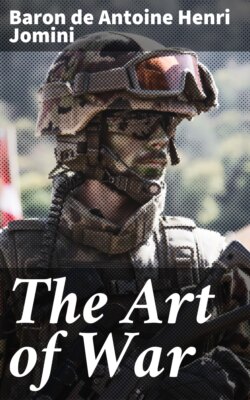Читать книгу The Art of War - baron de Antoine Henri Jomini - Страница 2
На сайте Литреса книга снята с продажи.
Table of Contents
ОглавлениеPREFACE
SUMMARY
OF
THE ART OF WAR.
DEFINITION OF THE ART OF WAR.
CHAPTER I.
STATESMANSHIP IN ITS RELATION TO WAR.
ARTICLE I.
Offensive Wars to Reclaim Rights.
ARTICLE II.
Of Wars Defensive Politically, and Offensive in a Military Point of View.
ARTICLE III.
Wars of Expediency.
ARTICLE IV.
Of Wars with or without Allies.
ARTICLE V.
Wars of Intervention.
ARTICLE VI.
Aggressive Wars for Conquest and other Reasons.
ARTICLE VII.
Wars of Opinion.
ARTICLE VIII.
National Wars.
ARTICLE IX.
Civil Wars, and Wars of Religion.
ARTICLE X.
Double Wars, and the Danger of Undertaking Two Wars at Once.
CHAPTER II.
MILITARY POLICY.
ARTICLE XI.
Military Statistics and Geography.
ARTICLE XII.
Other Causes which exercise an Influence upon the Success of a War.
ARTICLE XIII.
Military Institutions.
ARTICLE XIV.
The Command of Armies, and the Chief Control over Operations.
ARTICLE XV.
The Military Spirit of Nations, and the Morale of Armies.
CHAPTER III.
STRATEGY.
DEFINITION OF STRATEGY AND THE FUNDAMENTAL PRINCIPLE OF WAR.
THE FUNDAMENTAL PRINCIPLE OF WAR.
OF STRATEGIC COMBINATIONS.
ARTICLE XVI.
Of the System of Operations.
ARTICLE XVII.
Of the Theater of Operations.
ARTICLE XVIII.
Bases of Operations.
Fig. 1.
Fig. 2.
ARTICLE XIX.
Strategic lines and Points, Decisive Points of the Theater of War, and Objective Points of Operations.
OBJECTIVE POINTS.
ARTICLE XX.
Fronts of Operations, Strategic Fronts, Lines of Defense, and Strategic Positions.
FRONTS OF OPERATIONS AND STRATEGIC FRONTS.
LINES OF DEFENSE.
STRATEGIC POSITIONS.
ARTICLE XXI.
Zones and Lines of Operations.
OBSERVATIONS UPON THE LINES OF OPERATIONS IN THE WARS OF THE FRENCH REVOLUTION.
Fig. 3.
THE STRATIGIC FIELD OF 1806.
MAXIMS ON LINES OF OPERATIONS.
Fig. 4.
OBSERVATIONS UPON INTERIOR LINES—WHAT HAS BEEN SAID AGAINST THEM.
ARTICLE XXII.
Strategic Lines.
ARTICLE XXIII.
Means of protecting a Line of Operations by Temporary Bases or Strategic Reserves.
STRATEGIC RESERVES.
ARTICLE XXIV.
The Old System of Wars of Position and the Modern System of Marches.
ARTICLE XXV.
Depots of Supplies, and their Relation to Marches.
ARTICLE XXVI.
The Defense of Frontiers by Forts and Intrenched Lines.—Wars of Sieges.
INTRENCHED LINES.
ARTICLE XXVII.
The Connection of Intrenched Camps and Têtes de Ponts with Strategy.
TÊTES DE PONTS.
ARTICLE XXVIII.
Strategic Operations in Mountains.
ARTICLE XXIX.
Grand Invasions and Distant Expeditions.
EPITOME OF STRATEGY
CHAPTER IV.
GRAND TACTICS AND BATTLES.
ARTICLE XXX.
Positions and Defensive Battles.
ARTICLE XXXI.
Offensive Battles, and Different Orders of Battle.
Fig. 5. [25]
Fig. 6.
Fig. 7.
Fig. 8.
Fig. 9.
Fig. 12.
Fig. 12 bis .
Fig. 13.
Fig. 14.
Fig. 15.
Fig. 16.
ARTICLE XXXII.
Turning Maneuvers, and too extended Movement in Battles.
ARTICLE XXXIII.
Unexpected Meeting of Two Armies on the March.
ARTICLE XXXIV.
Of Surprises of Armies.
ARTICLE XXXV.
Of the Attack by Main Force of Fortified Places, Intrenched Camps or Lines.—Of Coups de Main in General.
COUPS DE MAIN.
CHAPTER V.
OF SEVERAL MIXED OPERATIONS, WHICH ARE IN CHARACTER PARTLY STRATEGICAL AND PARTLY TACTICAL.
ARTICLE XXXVI.
Of Diversions and Great Detachments.
ARTICLE XXXVII.
Passage of Rivers and Other Streams.
ARTICLE XXXVIII.
Retreats and Pursuits.
ARTICLE XXXIX.
Of Cantonments, either when on the March, or when established in Winter Quarters.
ARTICLE XL.
Descents.
CHAPTER VI.
LOGISTICS; OR, THE PRACTICAL ART OF MOVING ARMIES.
ARTICLE XLI.
A few Remarks on Logistics in General.
ARTICLE XLII.
Of Reconnoissances and other Means of gaining Correct Information of the Movements of the Enemy.
CHAPTER VII.
OF THE FORMATION OF TROOPS FOR BATTLE, AND THE SEPARATE OR COMBINED USE OF THE THREE ARMS.
ARTICLE XLIII.
Posting Troops in Line of Battle.
Different Formations of Lines of Battle for Two Corps of Infantry.
Fig. 17.
Fig. 18.
Fig. 19.
Fig. 20.
Fig. 21.
Fig. 22.
Formation of Two Corps of Three Divisions of Two Brigades each.
Fig. 23.
Fig. 24.
Fig. 25.
Two Corps of Three Divisions of Three Brigades each.
Fig. 26.
Fig. 27.
Fig. 28.
ARTICLE XLIV.
Formation and Employment of Infantry.
FIG. 29. [46] Deployed in order of two lines.
Fig. 30. Twelve battalions in columns of attack in two lines, with skirmishers in the intervals.
Fig. 31.
Fig. 32.
Fig. 33.
Fig. 34.
Fig. 35. Division in battalion squares.
Fig. 36. The same division in long battalion squares.
Fig. 37. Squared of regiments of three battalions.
ARTICLE XLV.
Cavalry.
Fig. 38. Cavalry division of five regiments. Cavalry deployed should be in checkered order rather than in full lines.
ARTICLE XLVI.
Employment of Artillery.
ARTICLE XLVII.
Of the Combined Use of the Three Arms.
CONCLUSION.
SUPPLEMENT
SUMMARY OF THE ART OF WAR.
NOTE
UPON
THE MEANS OF ACQUIRING A GOOD STRATEGIC COUP-D'OEIL.
Fig. 39.
Fig. 40.
SECOND APPENDIX
TO THE
SUMMARY OF THE ART OF WAR.
ON THE FORMATION OF TROOPS FOR BATTLE.
SKETCH OF THE PRINCIPAL MARITIME EXPEDITIONS.
INDEX
Map of portions of Germany, Switzerland & Italy.
